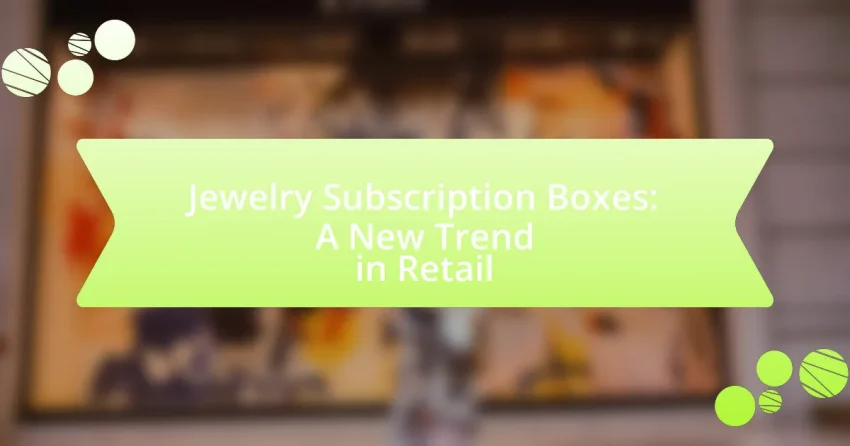Jewelry subscription boxes are curated packages that deliver a variety of jewelry items, such as necklaces, earrings, bracelets, and rings, to subscribers on a regular basis, typically monthly. This article explores how these subscription services operate, the types of jewelry included, and the structured plans available. It highlights the growing popularity of jewelry subscription boxes due to their convenience, personalization, and the element of surprise, as well as the trends in consumer behavior driving this demand. Additionally, the article discusses the benefits and potential drawbacks of these services, factors to consider when choosing a subscription box, and future trends expected in the market, including increased personalization and sustainability.

What are Jewelry Subscription Boxes?
Jewelry subscription boxes are curated packages that deliver jewelry items to subscribers on a regular basis, typically monthly. These boxes often include a variety of pieces such as necklaces, earrings, bracelets, and rings, allowing customers to discover new styles and brands without committing to a single purchase. The subscription model has gained popularity due to its convenience and the element of surprise, with many services offering personalized selections based on individual preferences. According to a report by Statista, the subscription box market is projected to reach $478 billion by 2025, highlighting the growing trend in retail, including jewelry.
How do Jewelry Subscription Boxes operate?
Jewelry subscription boxes operate by providing customers with a curated selection of jewelry items delivered regularly, typically monthly. Customers usually sign up for a subscription plan, which may involve selecting preferences regarding style, type, or price range. The subscription service then sends a box containing various jewelry pieces, allowing customers to try them out. Many services offer the option to purchase items at a discounted rate or return them after a trial period. This model caters to consumers seeking variety and convenience in their jewelry choices while also allowing businesses to maintain a steady revenue stream through recurring subscriptions.
What types of jewelry are typically included in these boxes?
Jewelry subscription boxes typically include a variety of items such as necklaces, bracelets, earrings, and rings. These boxes often feature both fashion jewelry and fine jewelry, catering to different styles and preferences. Many subscription services curate their selections based on current trends, seasonal themes, or customer preferences, ensuring a diverse range of options. For instance, a study by the National Retail Federation highlights that subscription boxes have gained popularity due to their ability to provide personalized experiences and convenience, making them appealing to consumers seeking unique jewelry pieces.
How are the subscription plans structured?
Subscription plans for jewelry boxes are typically structured into tiered levels, offering varying price points and benefits. For example, a basic plan may provide a limited selection of jewelry items monthly, while a premium plan could include exclusive pieces, personalized selections, or additional perks such as discounts on future purchases. This tiered structure allows customers to choose a plan that best fits their budget and preferences, enhancing the overall shopping experience.
Why are Jewelry Subscription Boxes becoming popular?
Jewelry subscription boxes are becoming popular due to their convenience, personalization, and the element of surprise they offer consumers. These services allow customers to receive curated selections of jewelry tailored to their preferences, making it easier for them to discover new styles without the need to visit multiple stores. According to a report by McKinsey & Company, the subscription box market has grown significantly, with a projected annual growth rate of 18.3% from 2021 to 2026, indicating a strong consumer interest in subscription-based retail models. This trend reflects a broader shift towards experiential shopping, where consumers value unique and personalized experiences over traditional purchasing methods.
What trends in consumer behavior are driving this popularity?
The trends in consumer behavior driving the popularity of jewelry subscription boxes include a growing preference for personalized shopping experiences and the increasing demand for convenience. Consumers are increasingly seeking unique, curated items that reflect their individual styles, which subscription services provide through tailored selections. Additionally, the rise of e-commerce has made it easier for consumers to access these services, as they can receive products directly at home without the need for in-store visits. According to a report by McKinsey & Company, 75% of consumers are willing to try new shopping experiences, highlighting the shift towards subscription models that offer flexibility and novelty in purchasing jewelry.
How do these boxes cater to the needs of modern consumers?
Jewelry subscription boxes cater to the needs of modern consumers by offering convenience, personalization, and variety. These boxes provide a curated selection of jewelry delivered directly to consumers’ homes, saving them time and effort in shopping. Additionally, many subscription services allow consumers to customize their preferences, ensuring that the jewelry aligns with their personal style and taste. This model also introduces consumers to new brands and designs that they may not have discovered otherwise, enhancing their shopping experience. According to a report by McKinsey & Company, subscription services have seen significant growth, with 15% of online shoppers participating in subscription services, indicating a strong consumer demand for this model.

What are the benefits of Jewelry Subscription Boxes?
Jewelry subscription boxes offer several benefits, including convenience, variety, and cost-effectiveness. Subscribers receive curated selections of jewelry delivered to their doorstep, eliminating the need for time-consuming shopping trips. This model allows individuals to explore different styles and brands without committing to a single purchase, enhancing their personal collection with diverse pieces. Additionally, many subscription services provide jewelry at a lower cost compared to retail prices, making it an economical choice for fashion enthusiasts. According to a report by McKinsey & Company, subscription services have seen significant growth, indicating a rising consumer preference for this shopping model.
How do Jewelry Subscription Boxes enhance the shopping experience?
Jewelry subscription boxes enhance the shopping experience by providing customers with curated selections of jewelry tailored to their preferences, which increases convenience and personalization. These subscription services often allow users to receive new pieces regularly, eliminating the need for time-consuming shopping trips and offering a surprise element that keeps the experience fresh and exciting. According to a study by McKinsey & Company, personalized shopping experiences can lead to a 10-30% increase in customer satisfaction, demonstrating the effectiveness of tailored offerings in enhancing the overall shopping journey.
What unique features do these boxes offer compared to traditional retail?
Jewelry subscription boxes offer personalized selections and convenience that traditional retail cannot match. These boxes typically curate items based on individual preferences, utilizing algorithms or stylist input to tailor choices, which enhances customer satisfaction. Additionally, they provide a flexible shopping experience, allowing customers to receive new jewelry regularly without the need to visit a store. This model often includes exclusive pieces not available in traditional retail, creating a sense of uniqueness and value. Furthermore, subscription services frequently offer lower prices compared to retail, as they eliminate overhead costs associated with physical stores.
How do they provide value for money?
Jewelry subscription boxes provide value for money by offering curated selections of jewelry at a lower cost than purchasing items individually. Subscribers typically receive multiple pieces each month, which can amount to significant savings compared to retail prices. For example, a subscription box may charge $30 per month for jewelry valued at $100 or more, allowing customers to enjoy high-quality items without the full retail expense. Additionally, these boxes often include exclusive designs not available elsewhere, enhancing perceived value.
What are the potential drawbacks of Jewelry Subscription Boxes?
Jewelry subscription boxes have several potential drawbacks, including the risk of receiving items that do not match personal taste or style. Many subscribers may find that the curated selections do not align with their preferences, leading to dissatisfaction. Additionally, the quality of jewelry can vary significantly between different subscription services, with some offering lower-quality items that do not justify the subscription cost. Furthermore, subscribers may face hidden fees, such as shipping costs or charges for returning unwanted items, which can increase the overall expense. Lastly, the commitment to a subscription can lead to unwanted accumulation of jewelry, resulting in clutter and potential buyer’s remorse.
What issues might consumers face with subscription services?
Consumers might face several issues with subscription services, including hidden fees, difficulty in cancellation, and receiving products that do not meet expectations. Hidden fees can lead to unexpected charges, as many subscription services may not clearly disclose all costs upfront. Difficulty in cancellation arises when consumers find it challenging to unsubscribe or when the process is not straightforward, leading to continued charges. Additionally, receiving products that do not align with personal preferences or quality expectations can result in dissatisfaction, as consumers may feel that the items do not justify the subscription cost. These issues can significantly impact the overall experience and perceived value of subscription services.
How can customers mitigate these drawbacks?
Customers can mitigate the drawbacks of jewelry subscription boxes by carefully researching and selecting reputable services that offer flexible return policies and high-quality products. By reading customer reviews and comparing different subscription options, customers can identify services that prioritize customer satisfaction and product authenticity. Additionally, utilizing trial periods or introductory offers allows customers to assess the value and quality of the jewelry before committing long-term. This approach reduces the risk of dissatisfaction and ensures that customers receive items that meet their expectations.

What factors should consumers consider when choosing a Jewelry Subscription Box?
Consumers should consider the quality of jewelry, subscription flexibility, pricing, and customer reviews when choosing a Jewelry Subscription Box. Quality is crucial as it determines the overall satisfaction and longevity of the pieces received; reputable subscription services often provide high-quality materials, such as sterling silver or gold plating. Subscription flexibility allows consumers to adjust their preferences, such as frequency of delivery or style choices, catering to individual tastes and lifestyles. Pricing should align with the consumer’s budget while also reflecting the value of the jewelry offered; many subscription boxes range from $20 to $50 per month, making it essential to evaluate what is included in that price. Lastly, customer reviews provide insight into the experiences of others, helping potential subscribers gauge the reliability and satisfaction levels associated with a specific service.
How do different subscription services compare?
Different subscription services for jewelry boxes vary in terms of pricing, selection, customization options, and delivery frequency. For instance, services like Rocksbox offer a rental model with a monthly fee of around $21, allowing users to borrow and swap jewelry, while others like My Jewelry Box provide ownership of pieces for a flat monthly rate, typically between $30 to $50. Additionally, some services, such as JewelMint, focus on personalized selections based on user preferences, enhancing the shopping experience. According to a report by Statista, the subscription box market is projected to reach $478.36 billion by 2025, indicating a growing trend in consumer interest and investment in subscription services, including jewelry.
What criteria should be used to evaluate these services?
To evaluate jewelry subscription box services, the criteria should include product quality, variety, pricing, customer service, and user reviews. Product quality assesses the materials and craftsmanship of the jewelry offered, ensuring they meet consumer expectations. Variety examines the range of styles and designs available, catering to different tastes and preferences. Pricing evaluates whether the subscription cost aligns with the perceived value of the jewelry received, considering market standards. Customer service measures the responsiveness and support provided to subscribers, which is crucial for resolving issues. User reviews offer insights into the experiences of previous customers, highlighting satisfaction levels and potential concerns. These criteria collectively ensure a comprehensive evaluation of jewelry subscription box services.
How important is customer feedback in selecting a service?
Customer feedback is crucial in selecting a service, particularly in the context of jewelry subscription boxes. It directly influences consumer trust and decision-making, as 79% of consumers trust online reviews as much as personal recommendations. Positive feedback can enhance a service’s reputation, while negative reviews can deter potential customers. In the jewelry subscription box market, where personalization and quality are key, customer feedback helps businesses refine their offerings and meet consumer expectations effectively.
What are the best practices for maximizing the value of a Jewelry Subscription Box?
To maximize the value of a Jewelry Subscription Box, customers should actively engage with the service by providing detailed preferences and feedback. This engagement allows the subscription service to tailor selections to individual tastes, increasing satisfaction and perceived value. Additionally, customers should take advantage of promotions and referral programs offered by subscription services, as these can enhance the overall experience and provide cost savings. Research indicates that personalized experiences in subscription services lead to higher customer retention rates, with a study by McKinsey showing that personalization can increase customer satisfaction by up to 20%.
How can subscribers make the most of their selections?
Subscribers can make the most of their selections by actively engaging with the customization options provided by their jewelry subscription service. Many subscription boxes allow subscribers to personalize their choices based on style preferences, occasion, and even current trends, which enhances satisfaction and ensures that the selections align with individual tastes. Research indicates that personalized experiences in retail lead to higher customer satisfaction rates, with a study by McKinsey showing that personalization can increase sales by 10 to 30 percent. By taking advantage of these customization features, subscribers can curate a collection that truly reflects their personal style and needs.
What tips can help in managing subscription costs effectively?
To manage subscription costs effectively, consumers should regularly review their subscriptions and eliminate those that are underused or unnecessary. Research indicates that 84% of consumers underestimate their monthly subscription spending, highlighting the importance of tracking expenses. Additionally, opting for annual plans instead of monthly subscriptions can often lead to significant savings, as many services offer discounts for upfront payments. Utilizing free trials strategically allows consumers to assess the value of a subscription before committing financially. Lastly, setting a budget specifically for subscriptions can help in maintaining control over spending, ensuring that consumers do not exceed their financial limits.
What future trends can we expect in Jewelry Subscription Boxes?
Future trends in jewelry subscription boxes include increased personalization, sustainability, and the integration of technology. Personalization will become more prevalent as companies leverage data analytics to tailor selections to individual customer preferences, enhancing user experience. Sustainability will gain importance, with brands focusing on ethically sourced materials and eco-friendly packaging, reflecting consumer demand for responsible practices. Additionally, technology integration, such as augmented reality for virtual try-ons and AI for style recommendations, will enhance customer engagement and satisfaction. These trends are supported by market research indicating a growing consumer preference for personalized and sustainable products in the retail sector.
How might technology influence the evolution of these services?
Technology will significantly influence the evolution of jewelry subscription boxes by enhancing personalization and streamlining logistics. Advanced algorithms can analyze customer preferences and purchasing behavior, allowing companies to curate selections tailored to individual tastes. For instance, data from a 2021 McKinsey report indicates that personalized experiences can increase customer satisfaction and retention rates by up to 30%. Additionally, technologies like augmented reality (AR) enable customers to virtually try on jewelry, improving engagement and reducing return rates. Furthermore, automation in supply chain management can optimize inventory levels and reduce delivery times, making the service more efficient and appealing to consumers.
What innovations are likely to emerge in the subscription jewelry market?
Innovations likely to emerge in the subscription jewelry market include personalized customization options, augmented reality (AR) try-on experiences, and sustainable sourcing practices. Personalized customization will allow subscribers to select styles, materials, and even engravings tailored to their preferences, enhancing user engagement and satisfaction. AR technology will enable customers to virtually try on jewelry pieces before receiving them, improving the shopping experience and reducing return rates. Additionally, the trend towards sustainability will drive subscription services to offer ethically sourced materials and eco-friendly packaging, aligning with consumer demand for responsible consumption. These innovations are supported by market research indicating a growing consumer preference for personalized and sustainable products in retail.
